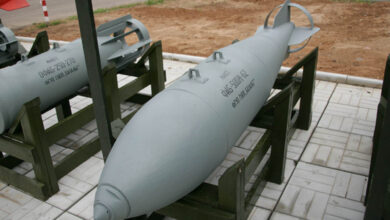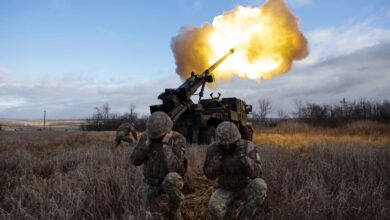Even after the United States Congress approved the single largest hike in defense spending for this fiscal year, a bipartisan commission has concluded that additional funding increases are necessary to ensure the U.S. military maintains its edge over rival powers like China and Russia.
The National Defense Strategy Commission – created as part of the 2017 National Defense Authorization Act – issued a report last week arguing that the Department of Defense must “accept greater cost and risk in pursuit of speed and the game-changing technological breakthroughs necessary to sustain U.S. military advantages.”
The NDSC report concludes that the U.S. is currently not capable of winning a decisive military victory in a situation where it would be forced to fight a two-front war with either China or Russia as well as a different adversary at the same time. Therefore, the commission concludes, more funding is necessary.
“The administration’s proposed budgets for [Fiscal Year] 2019 and beyond do not fund a level of military capacity and capability adequate to defeat either adversary should war occur while deterring other enemies simultaneously,” the report said.
Acknowledging President Donald Trump’s stated desire to cut the budget of every federal department by five percent for the next fiscal year, the commission argues that lawmakers should spare the military and look elsewhere to save money – namely “entitlement” programs like social security and subsidized health care programs Medicare and Medicaid.
As it stands today, the U.S. has by far the world’s biggest funded military. Congress authorized a record $712 billion for the Defense Department for FY2019, a $82 billion increase from the prior year, an increase which was in itself more than the entire defense budget of every other country except China.
Dan Grazier, a fellow at the Center for Defense Information at the Project on Government Oversight, believes the current U.S. military budget is more than enough as it is.

Grazier is a former Marine Corps captain who served multiple combat tours in Iraq and Afghanistan. In 2007, Grazier deployed to Al Anbar province, Iraq, where he lead a team of 16 Marines and four tanks through over 200 combat missions. After returning stateside to train armor officers, Grazier deployed to Helmand province, Afghanistan in 2013, serving as the Marine Corps’ Senior Watch Officer for Regimental Combat Team 7.
A critic of the “military-industrial-congressional-complex,” Grazier’s research at POGO is focused on issues of national security and Pentagon reforms.
Following the release of the NDSC report, The Defense Post spoke to Grazier about the future of the U.S. military and the role of the defense industry in influencing U.S. policy.

TDP: The National Defense Strategy Commission published a report last week calling for greater increases in military spending. As it stands now, the United States already spends by far the most of any country on its military – significantly more than Russia and China combined, for example. To the extent that there are effectiveness issues within the military, what’s your reaction to the notion that buying more and better and nicer and newer equipment is the answer to those problems?
DG: Well, it’s completely ridiculous. There’s a major logical fallacy involved. In the commission’s report, the idea that they’re trying to convey is that Russia and China are gaining on us in a technological sense – that we’re losing our edge as far as military technology goes. If that were true, they’re doing it by spending a fraction of what we are on military equipment.
So, obviously our problem is not one of resource levels. That being said, I don’t necessarily accept the premise that we’re losing our technology edge. And also, I don’t think the premise of the report is correct in the first place. Thinking of Russia and China in a strictly conventional military sense – that’s not the right paradigm.
It’s impossible for two nuclear powers to fight a conventional war. It just is. Any war that we would have with Russia or China – God forbid – would almost immediately go nuclear. So any discussion about conventional weapons in regards to Russia and China is ridiculous. That’s a major issue that we need to deal with in the first place. But again, the logical fallacy of us not spending enough is just glaring and it made me laugh out loud when I read just the executive summary of the report.
The report was done in true Washington fashion. Congress mandated this in the 2017 National Defense Authorization Act and it was just a transfer of responsibility. Elected officials in true Washington fashion wanted to avoid responsibility for something they knew was going to be politically unpopular. So they created a blue-ribbon panel that was going to outline the unpopular policy items – either raising defense spending or raising taxes to pay for it. That way they could say, “look, we didn’t want to do this but this blue-ribbon panel of experts said this is what we needed to do.” It’s just gross politics. They’re not accountable to the voters, so they can take the blame for the unpopular proposals. It provides them a political alibi.
TDP: At the recent American Conservative conference, you spoke about your experience in Iraq leading a tank platoon and being given a mission to pacify a civilian area. And you spoke to the sort-of inherent conflict between the tools that you had and the mission that you were asked to carry out. Is a situation like that a good example to illustrate the point that many of the wars that the U.S. actually is engaged in are not necessarily conventional wars and that we need different tools to be effective in them?
DG: There’s a lot there in that question. My experience in Iraq was that I was one small part of the overall mission in Iraq where the operational mission we were given was to pacify the population. So I was given many tasks within that. But again, within the broader mission, we were trying to win friends and influence people and you don’t necessarily do that with four tanks.
A tank is built to kill people and break things, essentially. And I promise you, if I drove my four tanks down your street on a given day, you’re not going to like me very much. That does not show that we’re there to do good things. So it became very obvious to me very quickly that what we were trying to do was going to be very difficult with the tools that we had. That prompted a lot of good discussions and some rather contentious arguments at times about the mismatch between the means that we had and the ends that we were trying to achieve.
And to the larger point of your question about the kinds of wars that we end up fighting – it’s an important one. We have an establishment where the military-industrial-congressional complex is set up and optimized to create a force geared towards great power conflicts because it likes buying the big expensive bombers, it likes buying tanks, it likes buying aircraft carriers. That’s what it’s optimized for because that’s where the money is. But the reality is, again, we can’t fight a conventional war against a nuclear power. Big power conflicts are really a thing of the past.
The simple fact is, we’re building a conventional military that doesn’t line up with the realities of modern conflicts. The entire world knows how the United States fights. We put that on display in Desert Storm – everybody saw how we wanted to fight that conflict and how we did fight that conflict. So everybody knows that you’re not going to be able to go toe-to-toe against the United States in a conventional sense.
So what do they do? They go to unconventional means. The jargon word for that is “hybrid conflict.” They’ll use conventional means against us when they can but more often than not they’ll use the unconventional, insurgency-type tactics. So, unfortunately, we have a big, lumbering military machine and they can run circles around us. We saw that in Iraq, we’re seeing that in Afghanistan. Our enemies can adapt very quickly to what we do but we don’t turn on a dime very well and there’s very little financial incentive in Washington to change the way we do business. We have this eternal conflict between the wars it looks like we want to fight and the wars that we actually do fight.
TDP: When you talk about changing the way we do business to better deal with insurgencies and unconventional strategies being used against us, what might that look like? What kinds of resources or training could the military put greater emphasis on that would make it more effective in these sorts of arenas?
DG: I would say that we need to begin with just education in general. A counter-insurgency fight is very much a thinking man’s fight. You need to have officers, for sure, who are very well read into the culture of the area in which they’re operating. And it’s not just officers, it needs to go down through the ranks as well. Because if you don’t understand the culture in which you’re operating, then you can make all kinds of faux pas’s that way and you’ll lose on the moral dimensions of conflict right away.
I can give you a really good example of that. In Afghanistan in 2001, right after 9/11, you had President Bush out there telling the Taliban that they needed to give up Osama bin Laden right away. Well, if you understand Pashtunwali, you’ll know that they couldn’t do that because one of the tenants of Pashtunwali is the principle of Nanawatai.
Have you seen Lone Survivor or are you familiar with that story with Marcus Luttrell? When the rest of his team was killed, he approached that Afghan farmer and he requested Nanawatai. That’s a very deeply ingrained cultural principle in that part of the world. It’s basically that they’re honor-bound to grant sanctuary and protection to anyone who asks for it, which is exactly what bin Laden had done with the Taliban after he was kicked out of Sudan.
When President Bush issued an ultimatum to the Taliban, they were essentially asking the Taliban to violate that. The Taliban would have lost all credibility amongst the people if they had given him up. So, it’s that basic cultural literacy that you have to start out with. We lack that cultural literacy because we only think about things in terms of American culture.
The other thing is that we’re the proverbial guy with the hammer where every single problem looks like a nail and we start hammering away. We spend hundreds of billions – if not trillions – of dollars building this military and so any time a problem pops up that seems like a military problem, we instantaneously start thinking about how how we can apply military force to it. But in many cases it isn’t a military problem that can be solved. It’s a cultural problem, so we have to use elements of diplomacy or industrial means or economic means. But we don’t, we almost instantly pull out that hammer and start hammering away at that nail.

TDP: You’ve written a lot about the F-35 fighter jet program and some of the underlying problems that are plaguing it. And when you look at the F-35 program, what do some of the problems you see with those programs tell you about the logic that lead to their creation in the first place?
DG: The F-35 is designed for the kinds of wars that the U.S. military establishment wants to fight. We always think in terms of those great power conflicts and the F-35 is built specifically for that. If you imagine the entire spectrum of conflict being like 12-feet-long, the right hand side of that spectrum is all out thermonuclear war. It’s the extreme end of conflict. On the far left side, you have the lower end.
What the F-35 is built for is a conflict that’s a millimeter or so from the right end of that spectrum. But it only fits there. It’s right below nuclear holocaust, but above pretty much anything else. It’s this very tiny, narrow band. And that’s the band that the military establishment thinks of and what it optimizes itself for. But the F-35 is almost wholly inappropriate for anything else.
It just goes back to having an understanding of the dimensions of war. People think in terms of levels of war: operational, strategic and tactical. But that’s secondary. You have to think in terms of moral, mental and physical. The F-35 is great for the physical aspect but it’s horrible particularly for the moral dimension. I saw it in Iraq and I saw it in Afghanistan – it’s the ultimate David and Goliath problem. The United States is Goliath. We go into Afghanistan and we use our big, huge weapons to fight very primitive enemies, basically. And in the 2,500 years that the David and Goliath story has been told, how many times have people gone with Goliath?
It’s a big problem. We’re going to use – and we have already used in a limited way – the F-35, with an average cost of $150 million, to bomb a stationary target in Afghanistan. That’s Goliath beating up on David. Because our adversaries can’t compete with that, we lose instantaneously on the moral dimension of conflict.

TDP: The co-chair of the National Defense Strategy Commission sits on the board of Northrop Grumman. Is there an inherent conflict of interest there? And in a broader sense, how great of a role does the defense industry lobby play in influencing policy?
DG: It’s massive. This is a big issue that our organization has worked on extensively over the last 35 years that we’ve been around. It’s one of the fundamental problems that we have with the military-industrial-congressional complex. My colleague Mandy Smithberger last week and the week before launched her revolving door database to highlight a lot of these issues. It’s something that Eisenhower warned about in his farewell address. It’s a big, giant problem.
I didn’t have to get past the front cover of this report to see exactly what was going on. The revolving door – oh God, it’s such an insidious problem that’s next to impossible to try to combat.
It’s something you hear about on a daily basis in the service. At the level where I was, I wasn’t dealing with generals on a daily basis. But the junior officers and the mid-grade officers, you’d hear them talk all the time about, “oh, this is going to set me up with this kind of a job.” I was in tanks. The Abrams [tank] is a General Dynamics system. The General Dynamics guys were around all of the time. They had the field service reps who were there in the tank units and reps were former service members. And these weren’t even officers. Sometimes they were NCOs that left the service and had gone to work for General Dynamics.
You don’t get those jobs by being the guy who criticizes the contractor. In the pursuit of those kinds of jobs on the back end of their military career they have to basically toe the party line. You can’t be critical of the systems. You can’t question decisions that are made because if you do, you’re not a good guy and you don’t get rewarded with those kinds of jobs.
This is on the lower end, but if you look at the higher end, on the general or officer level, you see these kinds of things all the time. One of the things Mandy used in her revolving door database is General [James] Cartwright. He was the vice-chair of the Joint Chiefs of Staff. He’s a Marine general and he was very instrumental in saving the JLENS, which was the big aerostat balloon that flew over Aberdeen, [Maryland] that broke loose famously and ended up on a joy ride through Pennsylvania. It was a huge boondoggle of a program that over $2 billion had been spent on over a number of years and it never worked.
We see these kind of issues all of the time and the army was requesting permission to cancel the program because they thought it was a drain on their resources. But General Cartwright was instrumental in saving it while he was still in uniform. But as soon as he retires, he goes to work for Raytheon, which was the contractor for that program. I guarantee you if he had allowed that project to get canceled, he probably would not have gotten that job.
Other examples, you look at Mark Welsh who was the Air Force Chief of Staff. The Air Force awarded the contract for the B-21 bomber to Northrop Grumman. Well, guess what? He becomes chairman of the board of Northrop Grumman as soon as he retires from the Air Force.
So, it’s those kinds of things– those very cosy relationships. It’s this perpetual problem, that undue influence. It’s a problem we’ve been trying to solve for a number of years and I don’t know how you do solve it.

TDP: After the killing of Jamal Khashoggi, there’s been a lot of discussion about reevaluating our military relationship with Saudi Arabia. Particularly as the humanitarian situation in Yemen also continues to grow more and more catastrophic, there have been calls to stop our support for the Saudi coalition and to stop selling arms to the kingdom. In response, President Trump and other officials have said they oppose doing that because it will eliminate American jobs in the defense industry. How effective is that tactic of connecting these arms sales to jobs, politically? And to what extent do you think that concern over jobs might be exaggerated?
DG: It’s greatly exaggerated. We have plenty of defense contractors building lots of weapons here in the U.S. Those weapons are sold overseas and that’s an important part of the bottom line for a lot of these companies. I do believe that the jobs created claims made by the Lockheed Martins and the Northrop Grummans of the world are greatly exaggerated.
You can look at the F-35 as a case study. Lockheed Martin created a website to kind of boost or promote the program. And right there, at the beginning of the page, they have the map that’s interactive and shows the amount of money invested and the number of jobs created in each particular state and sometimes even the congressional districts.
Researchers at Brown University have done some much better work on the real impact, but a lot of these jobs, they’re not full-time. If you’re a worker and you do any amount of work during a given year on the F-35 – it could be spending an hour working to help create some part on a wind-test article for the F-35 – they count that as a job. That’s not that employee’s full-time employment, that’s just one part of their employment throughout the year doing a lot of other things presumably.
So, the number of jobs that have been created have been greatly exaggerated over the years by the defense contractors. And they use this a cudgel with politicians on Capitol Hill and it works. I’ve literally had the chief of staff of a congressional office look me in the eye and tell me, “look, I don’t like the F-35 but we can’t do anything about it because it’s worth 1,000 jobs to us.” He didn’t mean literally 1,000 jobs. He meant it was going to be used as a campaign issue. In his next campaign, if they voted the wrong way on the F-35 issue, they knew that their opponent was going to say in a campaign ad that “so-and-so voted against jobs in our state and if I’m elected I’ll vote to save these jobs.”











